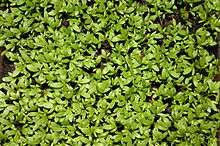Garden cress
| Garden cress | |
|---|---|
 | |
| Young plants | |
| Scientific classification | |
| Kingdom: | Plantae |
| (unranked): | Angiosperms |
| (unranked): | Eudicots |
| (unranked): | Rosids |
| Order: | Brassicales |
| Family: | Brassicaceae |
| Genus: | Lepidium |
| Species: | L. sativum |
| Binomial name | |
| Lepidium sativum L. | |
Cress (Lepidium sativum), sometimes referred to as garden cress to distinguish it from similar plants also referred to as cress (from old Germanic cresso which means sharp, spicy), is a rather fast-growing, edible herb.
Garden cress is genetically related to watercress and mustard, sharing their peppery, tangy flavor and aroma. In some regions, garden cress is known as mustard and cress, garden pepper cress, pepperwort pepper grass, or poor man's pepper.[1][2]
This annual plant can reach a height of 60 cm (~24 inches), with many branches on the upper part. The white to pinkish flowers are only 2 mm (1/12 of an inch) across, clustered in branched racemes.[3][4]
Garden cress in agriculture
Garden cress is commercially grown in England, France, the Netherlands and Scandinavia.[5]
Cultivation of garden cress is practical on both mass scales and on the individual scale. Garden cress is suitable for hydroponic cultivation and thrives in slightly alkaline water. In many local markets, the demand for hydroponically grown cress can exceed available supply, partially because cress leaves are not suitable for distribution in dried form, so they can only be partially preserved. Consumers commonly acquire cress as seeds or (in Europe) from markets as boxes of young live shoots.[5]
Edible shoots are typically harvested in one to two weeks after planting, when they are 5–13 cm (2 - 5 inches) tall.[6]
Cress in cookery
| Nutritional value per 100 g (3.5 oz) | |
|---|---|
| Energy | 134 kJ (32 kcal) |
|
5.5 g | |
| Sugars | 4.4 g |
| Dietary fiber | 1.1 g |
|
2.6 g | |
| Vitamins | |
| Vitamin A equiv. |
(43%) 346 μg (38%) 4150 μg12500 μg |
| Thiamine (B1) |
(7%) 0.08 mg |
| Riboflavin (B2) |
(22%) 0.26 mg |
| Niacin (B3) |
(7%) 1 mg |
|
(5%) 0.247 mg | |
| Vitamin B6 |
(19%) 0.247 mg |
| Folate (B9) |
(20%) 80 μg |
| Vitamin C |
(83%) 69 mg |
| Vitamin E |
(5%) 0.7 mg |
| Vitamin K |
(516%) 541.9 μg |
| Minerals | |
| Calcium |
(8%) 81 mg |
| Iron |
(10%) 1.3 mg |
| Magnesium |
(11%) 38 mg |
| Manganese |
(26%) 0.553 mg |
| Phosphorus |
(11%) 76 mg |
| Potassium |
(13%) 606 mg |
|
| |
| |
|
Percentages are roughly approximated using US recommendations for adults. Source: USDA Nutrient Database | |
Garden cress is added to soups, sandwiches and salads for its tangy flavor.[6] It is also eaten as sprouts, and the fresh or dried seed pods can be used as a peppery seasoning (haloon).[5] In England, cut cress shoots are commonly used in sandwiches with boiled eggs, mayonnaise and salt.

Other uses
Garden cress, known as chandrashoor, and the seeds, known as halloon[7] in India, are commonly used in the system of Ayurveda to prevent postnatal complications.
Garden cress seeds, since ancient times, have been used in local traditional medicine of India.[8] Seeds have been shown to reduce the symptoms of asthma and improve lung function in asthmatics.[9] The seeds have been reported as possessing a hypoglycemic property in rats[10] and the seed mucilage is used as a substitute for gum arabic and tragacanth.
Cress may be given to budgerigars.[11] Some use it in the belief that it can cure asthma, bronchitis bleeding piles.[12]
Some use Lepidium sativum seeds for indigestion and constipation.[13]
References
- ↑ Cassidy, Frederic Gomes and Hall, Joan Houston. Dictionary of American regional English, Harvard University Press, 2002. Page 97. ISBN 0-674-00884-7, ISBN 978-0-674-00884-7
- ↑ Staub, Jack E, Buchert, Ellen. 75 Exceptional Herbs for Your Garden Published by Gibbs Smith, 2008. ISBN 1-4236-0251-X, 9781423602514
- ↑ Vegetables of Canada. Published by NRC Research Press. ISBN 0-660-19503-8, ISBN 978-0-660-19503-2
- ↑ Boswell, John T. and Sowerby, James. English Botany: Or, Coloured Figures of British Plants. Robert Hardwicke, 1863. Page 215.
- 1 2 3 Vegetables of Canada. NRC Research Press. ISBN 0-660-19503-8, ISBN 978-0-660-19503-2
- 1 2 Hirsch, David P.. The Moosewood Restaurant kitchen garden: creative gardening for the adventurous cook. Ten Speed Press, 2005. ISBN 1-58008-666-7, ISBN 978-1-58008-666-0
- ↑ http://www.organicindia.com/PR_OH_chandrashoor.php
- ↑ The Wealth of Indian Raw Materials ,. New Delhi: Publication and information Directorate. 1979. pp. CSIR Vol 9, Page 71–72.
- ↑ NP, Archana; Anita, AM (2006). "A study on clinical efficacy of Lepidium sativum seeds in treatment of bronchial asthma". Iran J Pharmacol Ther 5: 55–59.
- ↑ M, Eddouks; Maghrani M; Zeggwagh NA; Michel JB (2005). "Study of the hypoglycaemic activity of Lepidium sativum L. aqueous extract in normal and diabetic rats". J Ethnopharmacol 97 (2): 391–395. doi:10.1016/j.jep.2004.11.030. PMID 15707780.
- ↑ Budgerigars - Diets, PDSA.
- ↑ Bhatiya, KN (1996). Modern Approach to Batany. India: Surya publications. p. 516.
- ↑ Najeeb-Ur-Rehman, Mehmood MH, Alkharfy KM, Gilani AU, "Prokinetic and laxative activities of Lepidium sativum seed extract with species and tissue selective gut stimulatory actions. J Ethnopharmacol. 2011 Feb 2;